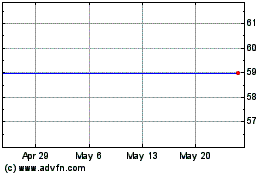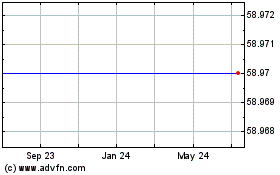By Justin Baer
Goldman Sachs Group Inc., beset by a steady decline in a
fixed-income trading operation that was once its most-reliable
source of profits, is turning for help to a business it once
eschewed for help: debt financing.
With its top-ranked mergers-and-acquisitions operation facing
more-limited growth prospects and debt trading under pressure from
new regulations, Goldman has identified loans and bond underwriting
as key sources of additional profit, according to officials at the
firm.
As part of the effort, Goldman has been opening its checkbook to
corporate clients wider than ever before. Last year, it offered to
lend Mylan NV $13.5 billion to help the drugmaker pay for its
hostile bid for Perrigo Co., which was ultimately abandoned. In
December, Goldman agreed to provide a $10 billion loan to help
finance Newell Rubbermaid Inc.'s acquisition of consumer-goods
rival Jarden Corp.
The two bridge loans are among the biggest solo commitments the
firm has ever made.
Such transactions are part of a push by Goldman to be a bigger
player in a corner on Wall Street long dominated by
commercial-banking giants such as J.P. Morgan Chase & Co.,
Citigroup Inc. and Bank of America Corp.
Goldman made its reputation by focusing on businesses like
merger advice, initial public offerings and, as the debt markets
grew, fixed-income trading. For years, the firm largely left bond
underwriting and corporate loans to those competitors with roots in
commercial banking.
But new rules on bank capital and risk taking have hemmed in
profits in fixed-income trading. The pool of debt-trading revenue
available to Wall Street exceeded $130 billion a year before the
financial crisis. It fell to $82 billion in 2015, according to
Citigroup analysts. That has taken its toll on banks' returns:
Goldman's return on equity, which exceeded 30% before the downturn,
has sat near 11% over the last several years.
To make matters worse, Goldman is bumping up against highs in
the market share it expects it can achieve in M&A and stock
sales.
As a result, the firm has been on the hunt for new sources of
income. That has meant embracing businesses that would have drawn
sneers from Goldman bankers a generation ago, including corporate
loans, bond issues--even online banking for retail customers.
Goldman, which converted to a bank holding company at the height
of the financial crisis, has directed its investment bankers to
tout the firm's debt-financing capabilities to clients, officials
said. That became an easier sell with borrowing costs historically
low and, more recently, a boom in corporate mergers--many fueled by
big helpings of cash.
"Funding and liquidity became critical challenges for our
clients to solve," Jim Esposito, Goldman's co-head of financing,
said in an interview. "As clients prioritized accessing the debt
markets with much greater intent, we followed our clients."
Mr. Esposito, along with his co-head, Marc Nachmann, was
recently named to Goldman's management committee.
So far, the effort appears to be paying off, which the bank's
fourth-quarter earnings report Wednesday is expected to show.
Goldman had $1.03 billion in debt-underwriting revenue in 2015,
fifth among Wall Street banks, according to Dealogic. That's up
from ninth in 2009.
Goldman still faces an uphill battle in winning debt business
over its bigger bank rivals, which do four to five times as much
lending to many big clients.
Goldman executives concede passing J.P. Morgan, Citi and BofA is
highly unlikely. But they see opportunities to take a bigger slice
of the business of European banks, many of which are pursuing
sweeping restructuring plans amid regulatory pressure.
Providing debt financing for riskier companies is becoming more
fraught, too.
Uncertainty over interest rates, economic growth in China and
plummeting commodity prices has turned markets choppier. In some
cases, companies and their banks have had to pull debt offerings
amid the tumult.
Last year, for example, Vista Equity Partners postponed a debt
sale to finance its buyout of Solera Holdings. In that deal,
Goldman provided the bridge loan. When bridge loans aren't replaced
with bond sales, banks are forced to keep the debt on their own
balance sheets, tying up capital and risking losses.
Still, none of that has deterred the effort, spearheaded in part
by David Solomon and John Waldron, co-heads of investment banking
who have deep roots in the debt-financing business.
Part of the push, according to the men and others at the firm,
involves a subtle but meaningful shift in how Goldman approaches
its core offering of financial advice, from which it raked in $809
million in the third quarter alone. Goldman has historically
focused on winning assignments from companies that are for sale, in
part because that is a safer bet than being with a bidder when
there are multiple suitors.
But increasingly, Goldman has sought to align itself with
buyers. The adviser to the buyer often also provides debt to help
finance the deal, which in turn can lead to other assignments, for
example protecting against currency or interest-rate risks. All
told, fees from these additional assignments can bring in as much
as three times what can be earned from advising, bankers say.
Bridge loans are designed as a placeholder until the acquirer
raises money through bond sales. Typically, firms that underwrite
those bond sales also get a leg up in trading the securities after
they are issued. That is because investors tend to flock to the
underwriters to buy or sell them, as those firms are more likely to
have them in stock or know where to get them.
Goldman had a front-row seat for the windfall banks can earn
when they are with the buyer in a big acquisition: They were on the
other side of the table when Actavis PLC, a drugmaker, hired J.P.
Morgan to advise on its $66 billion takeover of Allergan in
2014--and lead a $21 billion bond deal.
J.P. Morgan earned $65 million in merger-advisory fees and the
lion's share of the $133 million divvied up by the bond deal's
underwriters, according to a regulatory filing and analysts'
estimates.
(END) Dow Jones Newswires
January 19, 2016 05:44 ET (10:44 GMT)
Copyright (c) 2016 Dow Jones & Company, Inc.
Jarden (NYSE:JAH)
Historical Stock Chart
From Jun 2024 to Jul 2024

Jarden (NYSE:JAH)
Historical Stock Chart
From Jul 2023 to Jul 2024
